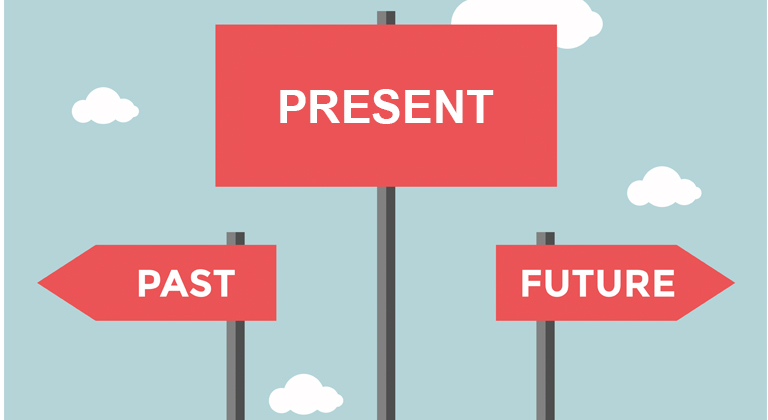Past Tense vs. Present Tense: Which should YOU choose?
Past tense vs. present tense is less a debate about which is better, and more about which is a better choice for your particular book. While many authors default to past tense, that may not always be ideal for your story as both tenses have their own unique strengths and challenges.
Today, Ginger examines the advantages of both past and present tense so that you can have a better understanding of when they should be used, and even provides examples of each from popular works of fiction. Having a strong grasp of narrative tense is important because choosing the right one for your story will help leave an impact on your reader and keep them coming back for more.
Recently, I was participating in a writing discussion when the topic of tenses came up. Other members of the group were surprised that a book we were discussing was written in the present tense – as in “she walks across the room” and “he opens the fridge.” In mainstream fiction, use of the present tense is pretty rare.
In romance, however, it might be an equally popular creative choice among authors as the more traditional past-tense narrative – and ultimately, that’s exactly what it is: A choice!
When it comes to crafting compelling stories, authors have a myriad of choices they can make to better weave their tale – and decisions about plot twists and character arcs are just part of that. One of the more fundamental decisions a writer must grapple with is the choice of narrative tense. Should they write in the past tense, or the present tense?
Many authors default to writing in the past tense – which is a perfectly valid decision. However, the tense an author chooses can shape not just the way the story is perceived by the reader, but also influence how deeply they’re engaged by your fictional world. In this article, I wanted to explore the nuances of using past tense versus present tense in fiction writing – and provide some examples from popular literature to demonstrate the impact it can have.
Past Tense: The Comfort of Hindsight
Most writers, especially in more mainstream genres, default to writing in past tense: “He said this” and “she did that.”
The past tense has been a trusted tool of storytellers for centuries, chiefly because it creates a comfortable sense of retrospection and distance between the reader and the written word. The past tense allows an author to recount events as if they’ve already happened, which in turn provides the reader with the context of narrative hindsight. This can provide a story with a more timeless quality, fostering a connection to historical settings and leveraging the underappreciated power of nostalgia.
Past Tense Example: F. Scott Fitzgerald’s “The Great Gatsby”
“So we beat on, boats against the current, borne back ceaselessly into the past.”
F. Scott Fitzgerald’s legendary tale of excess among the wealthy of Long Island uses the past tense to great effect, making the entire tale read like a real-life reminiscence of our narrator, Nick Carroway.
In the poignant conclusion to The Great Gatsby, Fitzgerald leans into the past tense to help add a sense of scale to Nick’s final thoughts – encapsulating the burden that time and memory have become for him. The retrospective viewpoint accentuates the idea that each of the characters’ pursuits and aspirations were ultimately futile – and heightens the novel’s theme of how illusory the American Dream truly is. Readers are given a sense of observing events from the outside in, experiencing the narrative as if they’re hearing it directly from Nick, and not having witnessed the events themselves.
Present Tense: The Pulse of Immediate Experience
Present tense is a much rarer narrative choice for authors, but it’s particularly effective in genres that rely on suspense, thrills, and first-person narratives. I’ve encountered it most frequently in the romance and horror categories.
Writing in the present tense thrusts your readers into the heart of the story, providing an immersive experience as if they were right there in the action, witnessing events unfolding in real-time. Writing in the present tense creates a heightened sense of immediacy, and can make readers feel like they’re active participants in your story’s unfolding drama. It is particularly effective in genres that rely on suspense, thriller, and first-person narratives.
Present Tense Example: Veronica Roth’s “Divergent”
“I have a theory that selflessness and bravery aren’t all that different.”
Veronica Roth’s best-selling YA sci-fi series debuted at #6 on the New York Times bestseller list and remained there for 11 weeks, selling over 6.7 million copies as of writing this article. In the opening lines of the first novel in the series, Roth uses the present tense to establish an immediate sense of intimacy and urgency that draws us into the thoughts and emotions of our protagonist, Beatrice – and quickly makes us feel comfortable as intimate observers of her internal musings.
The use of present tense throughout the series serves to amplify the immediacy of Roth’s relentless narrative, helping us experience Beatrice’s perspective as if we’re walking in her shoes; something that would be much more difficult in the past tense.
Which tense should you choose to write in?
While most authors will default to the tense they’re most comfortable writing in, the choice between writing in the past tense or present tense shouldn’t be arbitrary. If you possess the writing skills and commitment to write in the present tense, it can be a strategic decision that significantly influences how your readers could engage differently with your story.
Both the past tense and present tense present unique narrative strengths and challenges, and you can use either to better harness your narrative objectives. Here are some things to consider as you make that choice:
1. Setting and Atmosphere
Past tense is often preferred by authors writing historical fiction, or stories that transport readers to different eras. The distance past tense creates can infuse the narrative with a sense of history and tradition – as demonstrated in literary classics like Jane Austen’s Pride and Prejudice.
Alternatively, present tense lends itself to stories written in more contemporary settings, or for faster-paced narratives where a sense of immediacy is crucial. A great example of this can be found by reading Gillian Flynn’s Gone Girl.
2. Character Immersion
Writing in the present tense is excellent for bringing readers intimately close to your characters’ emotions and experiences. This can be especially effective in first-person narratives or stories in which the character’s internal journey takes center stage. A great example is J.D. Salinger’s divisive novel The Catcher in the Rye, which employs present tense to draw readers into Holden Caulfield’s raw and unfiltered thoughts.
For stories that require the point-of-view of multiple characters, or rely on withholding information to create a mystery for the reader to solve, past tense makes it a lot easier to provide a sense of detachment from our main character.
3. Action and Suspense
Present tense is a powerful tool for authors crafting scenes of action, tension, and suspense – or romance and sex!
The present tense can make readers feel like they’re right there in the story, standing alongside characters as events unfold in real time – demonstrated brilliantly in Suzanne Collins’ The Hunger Games, for example.
On the other hand, past tense can provide readers with a sense of anticipation, as if they’re sifting through a tale that has already unfolded. I used the example of mystery novels when I wrote about character immersion, and this next point is illustrated particularly well in books like Agatha Christie’s mystery novels.
Conclusion
Making the choice between writing in past tense or present tense shouldn’t be taken lightly. It’s a nuanced decision that can deeply impact the flavor of your narrative.
Writing in the past tense offers a sense of distance from the story, and the vantage point of reflection. It adds depth to mysteries and flashbacks and is the easiest tense for readers to jump right into.
Writing in the present tense can be jarring at first, but it quickly immerses readers more deeply into the emotions and sensations of your story – providing them with the immediacy of a shared experience.
Whichever tense you choose to write in depends on your story – but understanding the strengths and challenges of each tense can help with that choice. Align your narrative tense with the emotional goals of your story – because if you get that right, it can elevate your story’s impact, guide readers more effectively on the journey you lead them through, and help make sure your book resonates long after they’ve turned the final page!
Whether embracing the timelessness of the past tense or the kinetic energy of present tense, wield these tenses like tools – tools a craftsman can use to mold whole worlds and leverage real emotions that captivate readers from your opening first line to the very last word you write.











